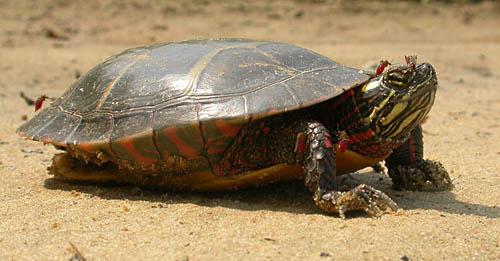Painted Turtle - Eastern
Sun Turtle Scientific Name: Chrysemys picta picta
Sat, 23rd November, 2024 - 10:23 am GMT
Sponsor Ads:

Alternative Name
Sun Turtle Scientific Name: Chrysemys picta pictaBasic Info
Eastern Painted Turtles are the most colorful species of turtle found in North America. They have a flat, smooth shell that is usually green. They usually have yellow or orange markings on the shell, most commonly a yellow stripe bisecting the shell and yellow and red edges. The plastron is usually tan, off white, or yellow, with or without markings. The Painted Turtle has yellow lines on the head and red lines on the neck. The jaws are narrow, with a notch in the middle of the upper lip. Like the neck, the legs and tail of the Eastern Painted Turtle often have red lines. Male Painted Turtles have long claws on their front feet and are slightly smaller than females. The Eastern Painted Turtle averages between 5 and 7 inches, and the longest specimen found was 7.1 inches.
Health
Breeding Eastern Painted Turtles mate between March and June. The courtship ritual is very graceful, with the male swimming past the female and stroking her head and neck. If the female is ready to mate, she strokes his limbs in turn. Mating occurs on the bottom of the pond. Between May and July, the female digs nests in sunny areas near the water. She lays clutches of between 2 and 20 eggs which hatch after about 76 days. The sex of the hatchlings is determined by the temperature of incubation. Higher temperatures, of 87 degrees Fahrenheit or higher, produce females, temperatures below 77 degrees Fahrenheit produce males. Both males and females will be born if the temperature is around 84 degrees Fahrenheit. Hatchlings have an "egg tooth," which they use to break out of the shell. This tooth falls off after a couple days after birth. The hatchling turtles may spend the winter in the nest. They can even survive being frozen.Habitat
Found throughout Mexico, the United States and CanadaBehavior
The Eastern Painted Turtle is a fairly small, brightly colored turtle found in North America. They are beautiful and can be good pets. Eastern Painted Turtles can often be found in ponds, lakes, and streams. They are often seen in groups on the beach and on logs basking in the sun. They will bask not only with other Painted Turtles but also with members of other turtle species. Their preferred habitats are soft-bottomed and slow moving, providing lots of vegetation to eat and hide in. The Eastern Painted Turtle is a diurnal animal, meaning they are active during the day. A large percentage of their day is spent basking on stumps, logs, and the banks of the streams. Painted Turtles are very timid animals and usually flee from approaching humans. Painted Turtles are most active during the summer and gradually become less active as winter approaches. By October or November, they are usually hibernating in the mud at the bottom of the stream. They become active again in March.Origin
Eastern United StatesHistory
The Painted Turtle has the broadest range of any species of turtle in North America. The Painted Turtle can be found throughout Mexico, the United States and Canada. There are four subspecies of Painted Turtle. The Eastern Painted Turtle subspecies is found throughout the Northeastern United States and is very common in Nova Scotia and Canada. They can be found as far south as Georgia and Alabama.Common Foods
Eastern Painted Turtles are omnivorous and feed on a variety of foods. Some favorite items include vegetation, insects, snails, and small crayfish and fish. Most of their preferred foods are found near lily pads.Sponsor Ads:
Man does not live by bread alone. But he damned well doesn't live without it, either. -- Unknown
Painted Turtle - Eastern
Coded by: BGID® | ALL RIGHTS RESERVED Copyright © 2000-2024
Disclaimer | Privacy | Report Errors / Contact | Credits









 Beware the new Naval power, they are planning to come on stream with big naval might to match their ground forces. Chinese Aircraft Carrier - Chinese Navy
Beware the new Naval power, they are planning to come on stream with big naval might to match their ground forces. Chinese Aircraft Carrier - Chinese Navy  versus
versus 
 versus
versus  This Thread is about the North Korean Military itself - the kind of army, navy, and air force they have.
This Thread is about the North Korean Military itself - the kind of army, navy, and air force they have. 
 versus
versus  versus
versus 
 versus
versus  versus
versus